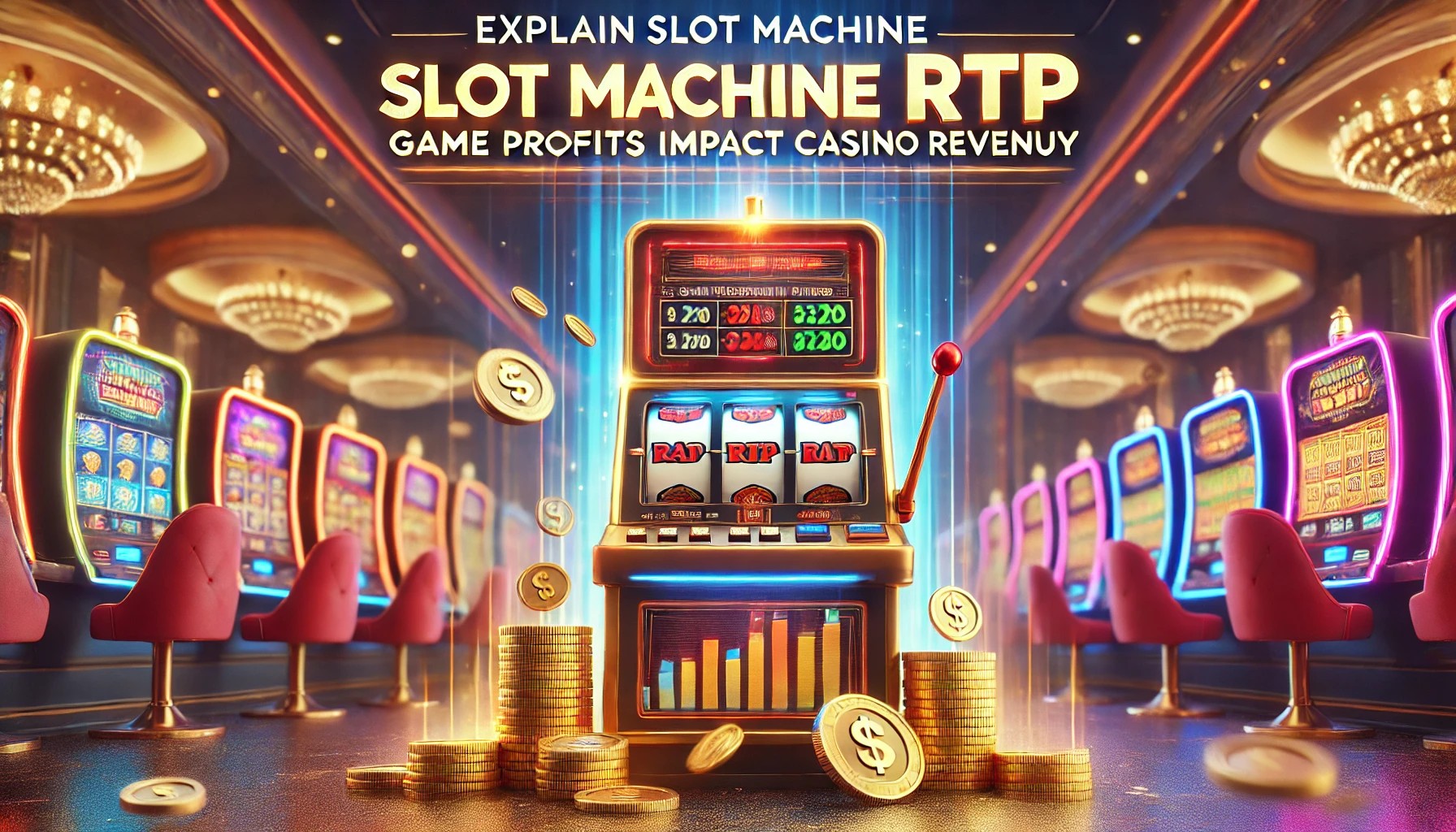Whether you are sitting down at a brick-and-mortar casino or an online slot machine, the excitement of striking the jackpot is accompanied by flashing lights and thrilling sounds. But underlying this fascinating experience is a crucial idea: Return to Player (RTP). RTP affects the casino’s bottom line as well as the player’s pleasure, hence it is not only a figure that shows on the game screen. We will dissect RTP in this post, investigate how it influences players and casinos, and look at how this vital statistic directly relates to the profitability of casino operations.
What is RTP (Return to Player)?
Return to Player (RTP) is a percentage that indicates how much of the total money wagered on a slot game is likely to be paid back to players over time. For example, an RTP of 96% means that, on average, for every $100 wagered, $96 will be returned to players, while the remaining $4 is the casinos profit.
It’s important to understand that RTP is calculated over a large number of spins often thousands or even millions and doesn’t guarantee specific outcomes for individual bets. RTP can vary between games, with each slot having its percentage, which is one reason why some slots feel more rewarding than others. Additionally, RTP is not fixed; it’s set by the game developers, but casinos may adjust it within certain limits.
The complement of RTP is the house edge, which represents the casino’s advantage (100% – RTP). While RTP is often used to evaluate the fairness of a game, it should be noted that it’s theoretical, representing long-term averages rather than short-term results. In other words, RTP gives an idea of what to expect in the long run, but it doesn’t predict the outcome of any specific spin.
How does RTP Affect Player Results?
Many players mistakenly believe that a high RTP guarantees frequent wins. In reality, while a higher RTP can indicate better long-term payout rates, it doesn’t mean that every player will walk away with a win. Let’s break this down:
- RTP and Variance: The RTP percentage reflects a slot’s long-term average payout, but variance (or volatility) plays a significant role in short-term results. High-variance games may have a lower frequency of wins but offer larger payouts when they do hit. On the other hand, low-variance slots pay out more frequently but in smaller amounts. Players who choose games based solely on RTP may overlook the importance of volatility, which can significantly affect their experience.
- Short-Term vs Long-Term: RTP comes into play in the long run, not in any given session. For example, a game with an RTP of 96% may payout differently over 100 spins versus 10,000 spins. As such, RTP cannot predict individual outcomes. Players may experience many losses before seeing any gains.
- Psychological Impact: Players may feel that a game with a high RTP is “fairer” or offers them a better chance of winning. While this is a common perception, it’s important to acknowledge that RTP is only a mathematical average. The excitement of the game, combined with the belief that higher RTP means more frequent wins, can influence player behavior. This is why casino marketing often highlights RTP figures.
Casino Revenue and RTP for Slots: The Connection
RTP is crucial to the casino industry because it plays a major role in shaping the revenue model of both online and land-based casinos. Casinos set RTP values strategically to balance player satisfaction with their own profit goals. Here’s how this works:
- Balancing Profit and Player Retention: Casinos must set RTP at levels that allow them to make a profit while keeping players coming back. If the RTP is too low, players may feel they are being cheated and stop playing. If it’s too high, the casino might lose money. So, the RTP percentage directly impacts the overall revenue of a casino.
- Impact of High RTP Slots: Some casinos offer high RTP slots as a way to attract players. These games may offer better payouts but are also part of a broader strategy to create customer loyalty. In such cases, casinos may make up for the lower house edge in other ways, such as through the volume of players or offering high-stakes games elsewhere in the casino.
- Online vs Land-Based Casinos: Online casinos often have higher RTPs than their land-based counterparts. This is because online casinos generally have lower operating costs, so they can afford to offer more favorable RTPs to players. In contrast, physical casinos have to account for costs like staff, maintenance, and energy, which can influence the RTP of their slot machines.
- Case Example: A popular online game might have an RTP of 97%. This could lead players to flock to that specific game, thinking it offers better odds. However, this could result in lower profits for the casino if the players win more often than expected. To balance this, casinos may adjust the RTP on other games or introduce bonus features that increase the house edge.
Why Casinos Set RTP Levels the As They Do?
Casinos set RTP levels with careful consideration. A variety of factors influence how they determine the payout percentage for their games:
- Game Development Cost: Developers spend a lot of time and resources to design slots with engaging graphics, sound effects, and features. These costs need to be recouped, and the RTP percentage can reflect the investment involved in the creation of the game.
- Player Demographics: Casinos analyze their target audience to set the most appropriate RTP. For instance, high rollers might be more attracted to slots with higher RTP and larger jackpots, while casual players may be drawn to more frequent, smaller payouts.
- Market Position: Some casinos position themselves as offering “fairer” games with high RTPs, while others may focus on high-stakes slots where the house edge is more substantial.
- Regulatory Compliance: In certain jurisdictions, casinos are required to set RTP within a specific range. These regulations are meant to protect players and ensure transparency in the gaming process.
With that said, casino operators often fine-tune RTP settings based on ongoing data and player feedback. This allows them to maintain a competitive edge while also fostering trust with their customers.
How RTP is Influenced by Slot Game Developers?
The RTP (Return to Player) of a game, which forms the basis of its payout system, is defined in great part by producers of slot games. Although casinos are somewhat free to change RTP within specific constraints, developers create the whole payment system depending on numerous elements.
RTP can be affected by gaming mechanics including multipliers, free spins, and bonus rounds since games with numerous bonus features could have somewhat lower RTP in return for more intense action. Progressive jackpots can also lower RTP percentages since part of every wager adds to the expanding jackpot pool, even if these games appeal to players because of their possible big payouts. Aiming to produce entertaining experiences with fascinating themes, high-quality graphics, and immersive additional features sometimes emphasizing these qualities above optimizing RTP developers also concentrate on user involvement.
Finally, market demand is important; if players favor games with higher RTPs, developers may create slots to satisfy these needs, as evidenced by well-known games like Blood Suckers 2 and Ugga Bugga, which are noted for their higher RTP percentages. Developers ultimately strike a mix between these several elements to produce games that are both interesting and satisfying.
Strategies of Players for Optimal RTP
While players cannot directly alter RTP, some strategies can help maximize the effectiveness of the RTP metric:
- Choose Games with High RTP: As a player, one of the easiest ways to optimize your chances is to seek out slots with higher RTP. Generally speaking, games with RTPs of 96% or higher offer better long-term payouts. Be sure to check the game’s RTP before playing.
- Consider Volatility: Don’t just focus on RTP; consider a game’s volatility as well. If you prefer frequent, smaller wins, low-variance slots may be more suitable for your style. On the other hand, if you’re after big payouts, high-variance games could be more exciting, though the wins may be rarer.
- Bankroll Management: While RTP can give you an idea of long-term outcomes, it’s still essential to manage your bankroll effectively. Set limits on how much you’re willing to spend and stick to them, regardless of the RTP of the game.
The Effect of RTP on Online vs. Land-Based Casinos
Variations in RTP (Return to Player) levels between online and land-based casinos can largely be attributed to running expenses. Online casinos typically have low overhead since they are not required to maintain actual facilities, staff, or utilities. As a result, they can afford to offer 3d product models, such as slots, with higher RTP percentages.
Many online games also display the RTP right inside the game, hence increasing user transparency. Conversely, land-based casinos may adjust the RTP on their slot machines based on their physical operations, which include rent, utilities, and staff wages, all of which determine their costs.
For some, playing at a real casino appeals because of the experience it offers. Players cherish the social scene, the excitement of being surrounded by people, and the immersive setting that online gambling cannot replicate.
Online slots usually have superior payout percentages, even if land-based casinos provide a unique, thrilling experience. Both types of casinos have advantages and disadvantages. Ultimately, players choices between the two come down to what they value more: a high RTP or the thrill of a live casino.
Future RTP Trends in Slot Machines
The idea of Return to Player (RTP) is not unique in the always-changing realm of slot machine software development. New patterns arising as technology develops might have a major influence on RTP going forward. Including smart technology especially artificial intelligence (AI) in slot games presents one of the most fascinating opportunities.
Based on many variables, including individual player behavior, game performance, and even the time of day, artificial intelligence might dynamically change RTP. This would enable casinos to customize the gaming environment to every individual, hence increasing happiness while nevertheless preserving revenue.
Virtual reality (VR) is another developing technique that might change how gamers view slots. Where players feel physically involved with the game in a way that conventional screens cannot imitate, VR could produce a more immersive and participatory atmosphere.
This higher degree of interactivity could inspire creative modifications in-game mechanics and payout systems, therefore presenting fresh chances for casino operators and game creators. These technologies could change not only the way slot games are played but also how RTP is created and changed, so transforming the gaming experience even more and personalizing it.
Conclusion
Basically, RTP is a fundamental component in comprehending the mechanics of slot machines and how they affect casino income as well as player behavior. Players should take into account not just the RTP but also the volatility and payout system of a game. For casinos, RTP offers a mix between keeping profitability and presenting fair, reasonable games.
Finally, consider games with good RTPs and carefully control your bankroll if you are a player trying to make more intelligent judgments. If you run a casino, remember that keeping patrons and guaranteeing the long-term viability of your gaming offers depend on properly determining the RTP.
It’s time to apply this knowledge and try your luck if you search for the greatest slot games with ideal RTP! Recall that you will be more suited to negotiate the fascinating world of slots the more knowledgeable you are about RTP.







Leave A Comment